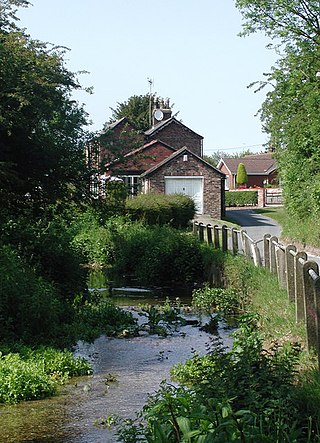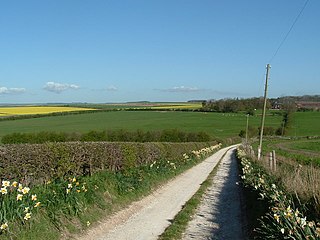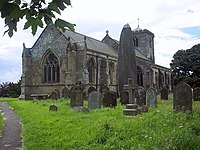
The Yorkshire Wolds are hills in the counties of the East Riding of Yorkshire and North Yorkshire in Northern England. They are the northernmost chalk hills in the UK and within lies the northernmost chalk stream in Europe, the Gypsey Race.

Flamborough is a village and civil parish in the East Riding of Yorkshire, England. It is situated approximately 4 miles (6 km) north-east of Bridlington town centre on the prominent coastal feature of Flamborough Head.

Wold Newton is a small Yorkshire Wolds village and civil parish in the East Riding of Yorkshire, England. It is situated approximately 9 miles (14 km) south of Scarborough and 9 miles (14 km) north-west of Bridlington. Wold Newton is located within the Great Wold Valley and the course of the Gypsey Race, a winterbourne chalk stream, passes through the south of the village. The village of Fordon is also part of the civil parish of Wold Newton. According to the 2011 UK census, Wold Newton parish had a population of 337, an increase on the 2001 UK census figure of 291.

Hunmanby is a large village and civil parish in North Yorkshire, England. It was part of the East Riding of Yorkshire until 1974. From 1974 to 2023 it was in the Scarborough district of the shire county of North Yorkshire. In 2023 the district was abolished and North Yorkshire became a unitary authority. It is on the edge of the Yorkshire Wolds, 3 miles (4.8 km) south-west of Filey, 9 miles (14 km) south of Scarborough and 9 miles (14 km) north of Bridlington. The village is on the Centenary Way.

Burton Agnes is a village and civil parish in the East Riding of Yorkshire, England. It is situated on the A614 road midway between Driffield and Bridlington.

Kilham is a village and civil parish in the East Riding of Yorkshire, England. It is situated about 5 miles (8 km) north-east of Driffield town centre. According to the 2011 UK census, Kilham parish had a population of 1,088, an increase on the 2001 UK census figure of 1,010.

Harpham is a small village and civil parish in the East Riding of Yorkshire, England. It is located just south of the A614 road, approximately 5 miles (8 km) north-east of Driffield and 7 miles (11 km) south-west of Bridlington.

Burton Fleming is a village and civil parish in the East Riding of Yorkshire, England. It lies close to the border with North Yorkshire. The village is situated approximately 7 miles (11 km) north-west of Bridlington and 6 miles (10 km) south of Filey.

The Rudston Monolith at over 25 feet (7.6 m) is the tallest megalith in the United Kingdom. It is situated in the churchyard in the village of Rudston in the East Riding of Yorkshire.

Thwing is a village and civil parish in the Yorkshire Wolds, in the East Riding of Yorkshire, England.
Octon is a hamlet, and shrunken medieval village in the East Riding of Yorkshire, England.

Fordon is a village and former civil parish, now in the parish of Wold Newton, in the East Riding of Yorkshire, England, near the border with North Yorkshire. It is situated approximately 8 miles (13 km) south of Scarborough and 10 miles (16 km) north-west of Bridlington. In 1931 the parish had a population of 29.

Bessingby is a village and former civil parish, now in the parish of Bridlington, in the East Riding of Yorkshire, England. It lies immediately south-east from the A614, approximately 1.5 miles (2.4 km) south-west from Bridlington. In 1931 the parish had a population of 106.

Butterwick is a village and former civil parish, now in the parish of Foxholes (1.75 miles to the east, near the village of Weaverthorpe, in North Yorkshire, England. The village lies in the Great Wold Valley and the course of the winterbourne stream the Gypsey Race passes through it. Until 1974 the village lay in the historic county boundaries of the East Riding of Yorkshire. From 1974 to 2023 it was part of the Ryedale district.

The Great Wold Valley is the largest and broadest of the valleys cutting into the Yorkshire Wolds in northern England. It carries the Gypsey Race, an intermittent stream, which runs from its source near Wharram-le-Street eastwards along and through the northern Yorkshire Wolds to reach the sea at Bridlington.

Foxholes is a village in North Yorkshire, England, part of the civil parish of Foxholes with Butterwick. It lies where the B1249 road crosses the Great Wold Valley, 9 miles (14.5 km) south from Scarborough, 11 miles (17.7 km) north-west from Bridlington, and 7 miles (11.3 km) north-east from Sledmere. The course of the winterbourne stream the Gypsey Race passes to the south of the village.
The East Riding of Yorkshire is a local government district with unitary authority status, and is a ceremonial county of England. It is named after the historic East Riding of Yorkshire which was one of three ridings alongside the North Riding and West Riding, which were constituent parts a Yorkshire ceremonial and administrative county until 1974. From 1974 to 1996 the area of the modern East Riding of Yorkshire constituted the northern part of Humberside.

The Gypsey Race is a winterbourne stream that rises to the east of Wharram-le-Street and flows through the villages of Duggleby, Kirby Grindalythe, West Lutton, East Lutton, Helperthorpe, Weaverthorpe, Butterwick, Foxholes, Wold Newton, Burton Fleming, Rudston and Boynton. The stream flows into the North Sea in Bridlington harbour. It is the most northerly of the Yorkshire chalk streams.

Rudston Roman villa is a Roman villa and scheduled monument near Rudston, East Riding of Yorkshire.

Argam, or Argham, was a civil parish and village in the East Riding of Yorkshire, England. The site is listed in many historical documents, but was deserted by the early 19th century, now being part of the civil parish of Grindale. The village was depopulated, becoming one of the known deserted Medieval villages in Yorkshire.





















